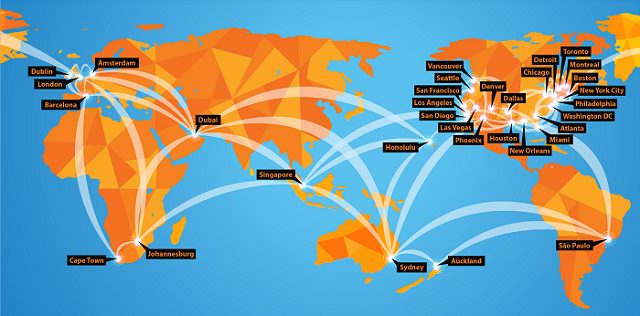Posts Tagged "Growth strategies"
Articles
- Best Marketing Conference Sponsorship
- What Does it Mean to Be an Exhibitor at a Conference?
- What Is the Biggest Social Media Conference?
- What Is an Innovation Conference?
- What Is a Typical B2B Event?
- What Are the Cloud Technology Events in 2025?
- Marketing Event Volunteer Opportunities: A Comprehensive Guide
- Digital Marketing Event Volunteer Opportunities Near Me
- What Does a Volunteer Do at a Conference?
- Is DigiMarCon Worth It?
- Is DigiMarCon Good?
- What is the Biggest Marketing Forum?
- What are Digital Marketing Conferences?
- Marketing Conference Exhibiting: Your Guide to Success
- Digital Summit Comparison: A Closer Look at DigiMarCon
- Digital Marketing Conference
- Digital Marketing Events: Your Guide to Success in 2025
- Marketing Conferences: Unlocking Your Business Potential in 2025
- What Is The Future of Digital Marketing in 2030?
- B2B Event Marketing Strategy: Unlocking Success For Your Business
- Why B2B Event Marketing?
- What Should a B2B Marketing Strategy Include?
- Top Marketing Conferences for 2025
- What Is the Future of Marketing in 2025?
Digital Marketing Conferences
- NORTH AMERICA
- DigiMarCon Cruise
(New Orleans, LA, USA) - DigiMarCon West
(Los Angeles, CA, USA) - DigiMarCon Northwest
(Seattle, WA, USA) - DigiMarCon Canada West
(Vancouver, BC, USA) - DigiMarCon Canada
(Toronto, ON, Canada) - DigiMarCon Canada East
(Montreal, QC, Canada) - DigiMarCon Florida
(Orlando, FL, USA) - DigiMarCon Gulf Coast
(Houston, TX, USA) - DigiMarCon Southern California
(San Diego, CA, USA) - DigiMarCon Midwest
(Chicago, IL, USA) - DigiMarCon Mid-South
(Nashville, TN, USA) - DigiMarCon Great Lakes
(Detroit, MI, USA) - DigiMarCon North
(Minneapolis, MN, USA) - DigiMarCon Central
(Kansas City, MO, USA) - DigiMarCon Texas
(Dallas, TX, USA) - DigiMarCon New England
(Boston, MA, USA) - DigiMarCon Mid-Atlantic
(Philadelphia, PA, USA) - DigiMarCon South Florida
(Miami, FL, USA) - DigiMarCon Southeast
(Atlanta, GA, USA) - DigiMarCon Central Florida
(Tampa, FL, USA) - DigiMarCon East
(New York, NY, USA) - DigiMarCon South Atlantic
(Charlotte, NC, USA) - DigiMarCon America
(Washington, D.C. USA) - DigiMarCon Northern California
(San Francisco, CA, USA) - DigiMarCon Rocky Mountains
(Denver, CO, USA) - DigiMarCon South
(San Antonio, TX, USA) - DigiMarCon Silicon Valley
(San Jose, CA, USA) - DigiMarCon Orange County
(Anaheim, CA, USA) - DigiMarCon Southwest
(Phoenix, AZ, USA) - DigiMarCon World
(Las Vegas, NV, USA)
- DigiMarCon Cruise
- LATIN AMERICA
- EUROPE
- MIDDLE EAST
- AFRICA
- ASIA PACIFIC
- DigiMarCon Hawaii & Pacific
(Honolulu, HI, USA) - DigiMarCon Asia & Japan
(Tokyo, Japan) - DigiMarCon New Zealand
(Auckland, New Zealand) - DigiMarCon Australia
(Sydney, Australia) - DigiMarCon Oceania
(Melbourne, Australia) - DigiMarCon Southeast Asia
(Singapore) - DigiMarCon India
(New Delhi, India) - DigiMarCon North Asia & China
(Shanghai, China)
- DigiMarCon Hawaii & Pacific
- VIRTUAL
Digital Marketing Blog
- What Makes DigiMarCon Stand Out (And Is It Worth It?) October 30, 2025
- Is DigiMarCon Worth Attending? A Complete Breakdown October 29, 2025
- DigiMarCon for Startups: Why Founders Shouldn’t Miss It October 29, 2025
- DigiMarCon Recap: What Went Down and What’s Next October 29, 2025

































Web Analytics: Uncover Data-Driven Strategies for Growth
In today’s digital world, knowing your online presence is key to success. Data-driven strategies can boost your marketing, leading to better customer interaction and more sales.
Using digital marketing metrics, you can learn a lot about your website. You’ll find out what’s working well and what needs work.
As you face the online world’s challenges, Web Analytics is crucial. It helps guide your decisions, grows your business, and increases your return on investment.
Key Takeaways
The Power of Data-Driven Decision Making
Data-driven decision making turns raw data into useful insights. It helps businesses move away from guessing and towards strategies backed by facts. This is made possible through website data analysis.
User behavior tracking is key in this process. It lets companies see how people use their website. This info helps spot areas to get better and make the site more user-friendly.
Many businesses have found success thanks to data-driven decisions. For example, analyzing how users behave helps shape marketing plans. This makes campaigns more effective and boosts business results.
Choosing a data-driven path helps businesses grow and stay ahead. As the digital world keeps changing, the role of data-driven decisions will grow too.
Understanding Web Analytics Fundamentals
Web analytics is key for any business wanting to grow with data. It’s about collecting, analyzing, and sharing data on how people use websites. This helps companies know their audience, track their online success, and make smart choices for their digital plans.
Web analytics tools gather lots of data, like how many times a page is viewed and how long people stay. These numbers show how users act, helping businesses spot what to improve and where to grow. By looking at this data, companies can make their marketing better, improve user experience, and get more sales.
SEO analytics plays a big part in web analytics. It looks at how search engines see a website, like keyword rankings and organic traffic. By using SEO analytics, businesses can make their site more visible in search results. This brings in more visitors and boosts their online presence.
In short, knowing web analytics is vital for businesses to succeed online. By using web and SEO analytics, companies can understand their audience better, improve their digital plans, and grow steadily.
Essential Web Analytics Metrics for Business Growth
Web analytics metrics are key to shaping business strategies. They offer insights into website performance metrics and conversion rates. This knowledge helps businesses grow and improve their online presence.
Conversion tracking is a vital part of web analytics. It tracks actions on a website, like filling out forms or making purchases. This helps businesses spot areas for improvement and boost their site’s performance.
Important website performance metrics include page load time, bounce rate, and average session duration. These metrics show how users interact with a site. A high bounce rate might mean the site’s content isn’t right for its audience or the user experience is bad.
Conversion tracking is also key for marketing success. It shows which marketing channels work best. This way, businesses can focus their efforts on the most effective channels, ensuring a good return on investment.
Regularly reviewing website performance metrics and conversion tracking data is crucial. This helps businesses spot trends, fix problems, and seize new opportunities. It’s a continuous process that drives growth.
By focusing on the right web analytics metrics and using conversion tracking tools, businesses can improve their online strategies. This leads to better user experiences and more conversions and revenue.
Popular Web Analytics Tools and Platforms
Finding the right web analytics tool is crucial. It can make all the difference between gaining valuable insights and missing out. Businesses need to pick a tool that fits their goals and offers useful data.
Adobe Analytics is a top choice for deep analysis of customer behavior. It gives real-time data, helping businesses make quick decisions. It also lets you segment data, so you can see how different groups behave.
Adobe Analytics
Adobe Analytics is known for its detailed analytics. It includes predictive analytics and customer journey mapping. These features help businesses predict what customers want and plan their strategies.
Matomo and Open-Source Alternatives
Matomo is a great open-source option for those not wanting to use a paid tool. It gives you control over your data and ensures privacy. It offers detailed insights into user behavior, just like Google Analytics, but you own the data.
When picking a web analytics tool, think about data privacy, how easy it is to use, and if it works with other marketing tools. Whether it’s Adobe Analytics, Matomo, or something else, the goal is to find a tool that gives you valuable insights and helps your business grow.
The right web analytics tool depends on what your business needs. By knowing what each tool offers, you can make a choice that boosts your online success.
Implementing Web Analytics Strategy on Your Website
A good web analytics strategy is key for making decisions based on data. To begin, you must set up the right analytics tools on your site. This means picking a strong analytics platform that tracks your digital marketing metrics well.
After that, you need to define key performance indicators (KPIs). These KPIs should match your business goals, like more website visitors, more conversions, or better user interaction. By focusing on the right metrics, you can understand how your website is doing.
With your analytics tools set and KPIs in place, you can use the data to shape your marketing plans. This could mean optimizing your content, finding the right audience, or changing your marketing channels. Checking your website data often helps spot areas to get better and see if your strategies are working.
By adding web analytics to your daily work, you can make smarter choices. This leads to ongoing betterment of your online presence.
Uncovering User Behavior Insights Through Analytics
Businesses can learn a lot about user behavior by using web analytics. These tools show how users move around a website. They reveal what users like and what they find hard.
User behavior tracking is key in web analytics. It helps businesses see how users interact with their site. By looking at page views, bounce rates, and how long users stay, companies can spot areas to get better.
SEO analytics is also important. It helps businesses see how users find their site. By looking at search data, companies can find the right keywords. This helps them rank higher in search results.
Web analytics tools can also show user feedback, heatmaps, and click rates. This info helps companies make their online marketing better. It improves how users engage and boosts sales.
By using both user behavior tracking and SEO analytics, businesses get a full picture of their online presence. This helps them make smart choices to grow their business.
Web Analytics for SEO and Content Optimization
To boost search rankings and content impact, knowing Web Analytics is key. Analyzing website performance metrics helps refine SEO and content for better results.
Web Analytics sheds light on user interactions, top pages, and areas for improvement. This info is vital for spotting SEO chances and tailoring content to user needs.
Web Analytics lets you track keyword success and tweak strategies. Knowing which keywords attract the most visitors helps improve content ranking.
Content Optimization Strategies
By using Web Analytics for SEO and content, businesses can grow online, attract more visitors, and increase sales. Keeping up with website performance metrics is crucial for staying ahead in the digital world.
Data-Driven Conversion Rate Optimization
Data-driven decision making is key to boosting conversion rates. By using web analytics, businesses can see big improvements. This leads to more customers and higher sales.
Understanding Conversion Tracking is vital. It helps spot where to improve in the conversion process. Tracking shows how users act on a site, from start to finish. This info helps find and fix problems.
To really boost conversion rates, businesses need to look at digital marketing metrics. Important ones are conversion rates, bounce rates, and how long users stay. These numbers help understand how well a site is doing and where it can get better.
Actionable Tips for Leveraging Web Analytics
By using these tips and making decisions based on data, businesses can see big gains in conversion rates. Keeping up with conversion tracking and digital marketing metrics helps spot trends and new chances to improve.
Key Takeaways:
Privacy, Ethics, and Compliance in Web Analytics
Web analytics gives us valuable insights into how users behave. But, it also raises big ethical and privacy issues. Businesses must collect and analyze user data in a way that respects privacy and follows the law.
The role of user behavior tracking is huge, but it needs a careful balance. Companies must be open about the data they gather and how they use it.
Following rules like the General Data Protection Regulation (GDPR) and the California Consumer Privacy Act (CCPA) is key. Businesses need to keep up with changing privacy laws and adjust their ways.
In short, dealing with web analytics while keeping user privacy and following rules is tough but vital. By being ethical and following the law, companies can earn trust from their users and create a better online space.
Case Studies: Web Analytics Success Stories
Web analytics has a big impact on business success. Real-world examples show how companies use SEO analytics and Google Analytics insights to grow. They improve their online presence and meet their marketing goals.
An e-commerce company saw a big drop in conversions. They used Google Analytics to find the problem. After improving their website, they saw a 25% increase in sales.
A digital marketing agency helped a client boost their search rankings. They used SEO analytics to understand keyword performance and user behavior. This led to a 50% increase in organic traffic.
These stories show how web analytics can help businesses succeed. By using Google Analytics insights, companies can find new ways to grow. They can also make their marketing better and get a better return on investment.
Conclusion: Building a Culture of Analytics for Sustainable Growth
Effective website data analysis is key for businesses wanting to grow. It helps them make smart decisions. By using web analytics tools, companies can understand how users behave and improve their online presence.
To grow sustainably, businesses need to value analytics. They should use data insights in all parts of the company. This includes marketing, sales, product development, and customer service.
By focusing on data, businesses can adapt fast to market changes. They can find new chances and stay ahead. As the digital world keeps changing, the role of website data analysis and tracking will grow even more.
FAQ
What is web analytics, and why is it important for business growth?
Web analytics is about collecting and analyzing website data. It helps businesses understand how users interact with their site. This knowledge is key to making smart decisions online.
How do web analytics tools work, and what role do they play in SEO?
Web analytics tools track website data. They show how users behave and where they come from. This info is vital for SEO, helping businesses improve their site and rank better in search engines.
What are the most critical web analytics metrics for measuring business growth?
Important metrics include website traffic, bounce rate, and conversion rate. They also look at session duration and pages visited. These metrics help understand user engagement and marketing success.
How can businesses use web analytics to inform their marketing strategies?
Analyzing web analytics data helps spot trends and areas for improvement. This info guides marketing efforts, helping refine targeting and ad campaigns. It also shapes content that appeals to the audience.
What are some popular web analytics tools, and how do they differ?
Tools like Google Analytics, Adobe Analytics, and Matomo are popular. Each has its own strengths and weaknesses. Businesses should pick a tool that fits their needs and goals.
How can businesses ensure they’re using web analytics ethically and in compliance with regulations?
Businesses should be open about data collection and ensure user consent. They must follow laws like GDPR. Also, protecting user data is crucial.
What is conversion rate optimization, and how can web analytics inform CRO efforts?
Conversion rate optimization aims to boost desired actions on a website. Web analytics helps by showing user behavior and funnel bottlenecks. This info guides website improvements.
How can businesses leverage web analytics to drive sustainable growth?
By using data to guide decisions, businesses can grow sustainably. Regularly analyzing data and making improvements is key. This approach enhances online presence and performance.